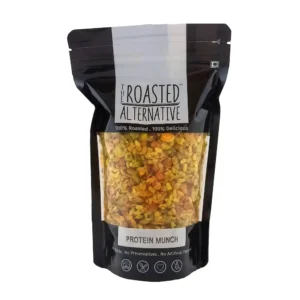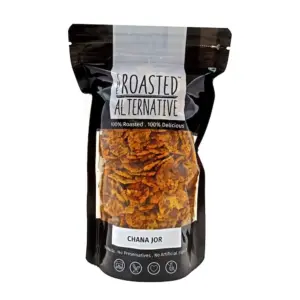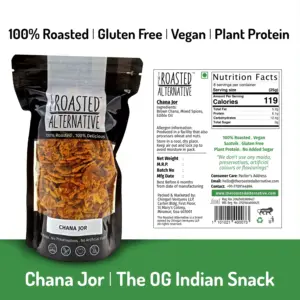Snack Smarter
Plant Protein Power! Do You Have It?
Quick, when you think of protein what comes to mind? Eggs? Chicken? Paneer? Milk? – they’re the usual suspects. But here’s the thing – protein doesn’t always need to come from animals. There’s a quiet powerhouse that’s been fuelling health-conscious diets for centuries – plant-based protein from legumes like green moong, kala chana, chana dal, yellow moong, etc.
So, now that we know there’s an alternate source of protein is it actually any better?
Legumes like green moong and kala chana are rich in protein, fibre, minerals and essential nutrients. Unlike processed protein supplements, they offer a natural, unrefined source of protein that your body absorbs efficiently.
For example, Green Moong contains approximately 24gms of protein per 100g, and is also packed with folate, antioxidants, and digestive-friendly fibre, or take kala chana – about 20gms of protein per 100g, and also a good source of iron, zinc, and low-glycemic carbs, making it perfect for sustained energy.
As a comparison, milk has about 3.5gms of protein in 100gms but is also a good source of potassium, calcium and other minerals, and vitamins. Paneer or cottage cheese on the other hand can have about 14-20gms of protein per 100gms (high protein paneer can have more).
100gms of chicken has about 20gms to 31gms of protein depending on the cut, and some other minerals.
Just how much protein do we need in a day?
According to experts, an average sedentary adult needs 0.8 gm of protein per kg of body weight. So, for example, if a person weighs 70 kg, he/she will need 56 grams of protein every day. The point to remember is that this can change depending on age and activity levels. As we grow older, we tend to lose muscle mass, and hence our protein intake should also be higher. For individuals who have a higher activity level, such as athletes, the recommended intake can even go upto 2gms per kg of body weight.
It is also better to spread out your protein consumption throughout the day.
Do proteins from different sources differ?
Animal proteins contain, what are called, complete proteins which contain all nine essential amino acids in consistent amounts (amino acids are organic compounds that your body uses to make proteins, so proteins are essentially a chain of amino acids. Our body needs 20 amino acids, 11 of which are produced by the body itself).
Most proteins from plants such as legumes, on the other hand, contain what are called incomplete proteins (i.e. not necessarily all the required amino acids). The good part is that you don’t need to eat complete proteins at every meal, you can get a mix of plant based proteins or, even better, a mix of all sources of proteins over the course of the day.
Each source has it’s place. but plant based protein does enjoy some additional health perks:
- It’s Got Fibre – Animal protein has zero fibre, while legumes come loaded with it. Result? Better digestion, feeling fuller, longer.
- It’s Cleaner – No cholesterol, no bad fats. Your heart’s going to thank you.
- Extra Nutrients – Apart from protein, you also get iron, zinc, magnesium, antioxidants – all the things your body needs daily.
- It’s Better For The Planet – Plant proteins have a much lower environmental impact than animal protein making them way more eco-friendly. So, when you snack on Roasted Moong Jor or Chana Jor from The Roasted Alternative, you’re choosing a protein source that’s kind to your body and the environment.
As more people move towards clean, wholesome eating, the spotlight is firmly on plant protein – and for good reason.
While legumes are inherently healthy, the way they are prepared also matters. Sure, fried snacks are tasty but they come with baggage: excess oil, refried fats, hidden additives – the usual culprits behind bloating and sluggishness.
That’s why roasted snacks are such a game-changer. The Roasted Alternative’s snacks are made by simply roasting green moong, kala chana, and other legumes to crispy perfection. No deep-frying. No artificial junk. Just natural, high-protein crunch.
Need a post-lunch munch? Grab a handful of Roasted Chana Jor.
Mid-day energy dip? The Roasted Protein Munch has your back.
Late-night snack cravings? Roasted Moong Jor is the perfect binge without the bulge.
You’re not just filling your tummy — you’re actually feeding your body the protein it needs.
Switching to plant protein snacks like roasted legumes isn’t about going vegan or giving up on flavour. It’s about choosing snacks that support your health, your energy levels, and your clean eating goals.
Because when it comes to flavour and wellness — you shouldn’t have to choose.
Links:
Milk (The Nutrition Source)
Chicken (NutritionIX)
Are you getting enough protein? (Mayo Clinic Health System)
What Are Complete Proteins? (Cleveland Clinic)







